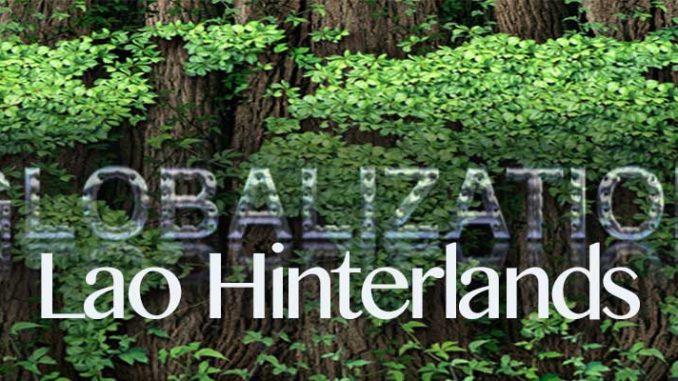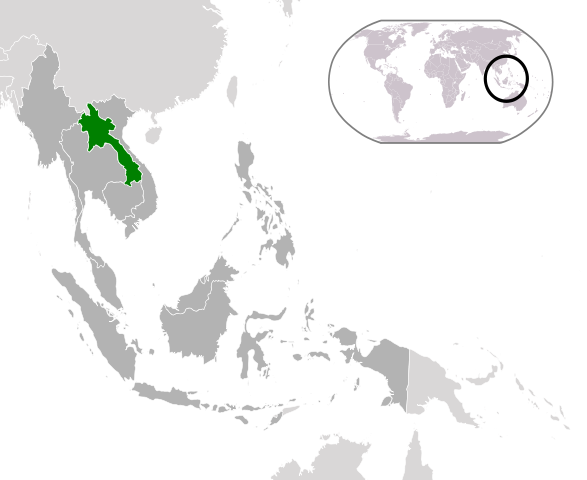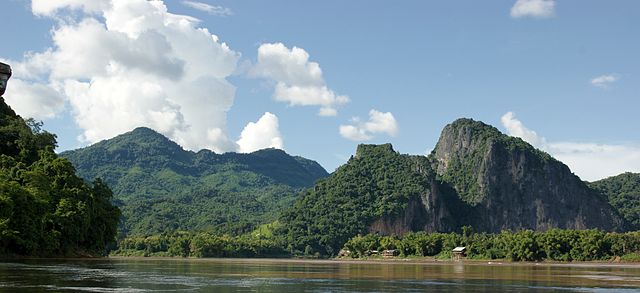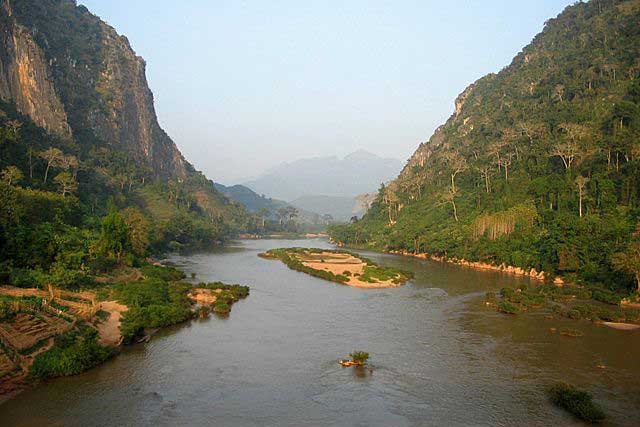
“Globalization” is only the most recent buzzword to describe the spread of ideas and material goods worldwide. Whether one personally considers globalization to be boon or bane, it is nonetheless a reality that affects almost everyone’s life. With products from around the world on local store shelves, most of us associate globalization closely with modern trade. Archaeological records, however, indicate that long distance, or international, trade has likely existed for more than two millennia. In my own area of interest, the trade in forest products, a long history is clearly evident.
In Southeast Asia in particular the early products of trade were essentially wild resources, including various spices, resins, decorative woods, deerskins, rhino horn, and the like. These products did not come from the port polities made famous by their export—Bangkok, Phnom Penh, or Saigon, on the mainland. These busy commercial centers were probably ringed for a considerable distance by rice fields. The products exported and unique to the natural environment were from further inland and especially upland—the produce of people living in relatively isolated tribal groups in forests. Ironically, the areas today considered “remote” have been involved in “globalization” for quite some time. In light of claims made by proponents and opponents of globalization, it is worth looking at how these historic linkages have affected this region, especially the hinterlands. We can consider this question briefly from the perspective of Laos, a small country at the heart of Southeast Asia.
Mountain crossroads
Officially known as the Lao People’s Democratic Republic (Lao PDR), Laos is the fourth smallest country in Southeast Asia; its population of a little over five million lives in an area of 237,000 square kilometers. The mountainous perimeter and upland plateaus vie in importance with the narrow strip of land along the Mekong River, which runs the length of the country from China in the north to Cambodia in the south. Although broken by rapids in many areas, the river has been a major conduit for the flow of goods and people throughout this region. Significantly, though, neither the river nor the mountains have been an effective barrier to the east-west flow of people, goods, and ideas, as indicated by Laos’ historic relations with neighboringVietnam to the east and Thailand and Burma to the west.
Largely protected by the Anamite mountain range from the ravages of the monsoon storms off the South China Sea, Laos enjoys a relatively mild, mainly tropical to subtropical climate, although temperature can fall to freezing at higher altitudes in the winter. Lying at the intersection of the Himalayan and Indo-Malayan biogeographical realms, with elevations ranging from 300 to nearly 3000 meters, the diverse landscape enjoys a high degree of endemism. With less than 5 percent of its total land area under cultivation and about 40 percent still under forest cover, Laos is biologically very rich. Indeed, in the past decade alone four new mammal species have been discovered in the mountain range shared by Laos and Vietnam.

in ASEAN (dark grey)
Political development
Although it is uncertain when inhabitants first came to this region, it is clear that many of the successive waves of migrants came from the north. From the second to the twelfth centuries a succession of powerful Khmer kingdoms—Funan, Chenla, and Angkor—rose and fell just to the south. In the latter half of the fourteenth century several chiefdoms in the central highlands united to form the first Kingdom of Laos. At its zenith Laos controlled an area including parts of what are now Yunnan (southwest China), Vietnam, Thailand, and Cambodia. Subsequently internal political rivalries fractured the state, and the weakened Lao kingdoms became at one time or another tributaries of neighboring Vietnam, Thailand, Burma (Myanmar), and Cambodia.
Political relationships in this early era were basically hierarchical. A regional ruler presided over local rulers, who in turn presided over local chieftains. Smaller polities paid tribute to larger, both as a show of deference and as payment for defense. Lao history has essentially been a sequence of power struggles for control over resources, namely the people and the products of the land. It was into such an environment of ever shifting loyalties that the first Europeans, missionaries and mercantilist explorers, arrived in the mid-seventeenth century. Over the next two centuries, France was able to gain sufficient foothold in Indochina to absorb Laos as a protectorate in 1893. Four decades of French colonial administration followed by region-wide conflict during World War II and the Indochina war kept Laos at least on the edge of the international stage. Only in 1975 was Laos able to shed the colonial yoke when communists seized power and established an independent government. Subsequent economic and political isolation as a member of the communist bloc became untenable with the downfall of its sponsor, the Soviet Union, about fifteen years later. For a little more than a decade now the country has been facing the challenge of reintegration into the international community.
Long history of linkages
With tributary payments at the base of many economic relationships, trade has played a key role in the development of Southeast Asia. As early as the second century BCE, China was conducting regular trade with South Asia and Burma. As the economically and most administratively advanced state in Asia, China could raise an army to protect important trade routes. Goods moved north from mainland Southeast Asia, overland into China, or south and east to ports on international maritime trade routes dominated by a succession of powerful trading states, from Indians and Arabs, to Chinese and Europeans. Intra-regional trade also flourished, often under the aegis of powerful local groups allied with the dominant regional power. Thus, Southeast Asian states have been historically important not only as emporia but as entrepots.
The obligatory tributes paid by vassal states along major trade routes included the usual gold and silver along with items unique to the area, especially products of local forests or seas. Prized for their rarity and novelty, such goods bolstered the prestige and power of their owners, brought acclaim to delivering government emissaries, and enriched the merchants in the trading mission. Archaeological evidence suggests that the early and early modern trading kingdoms of Southeast Asia, such as Funan, Angkor, and later Ayutthaya, were relatively sophisticated agricultural societies surrounded by extensive tracts under wet rice cultivation. It is unlikely that the citizens of these societies produced the forest products that figure prominently in the roster of tributary and export goods. Undoubtedly forest products were collected as trade or tribute from deferential groups upriver. Thus the fame of trading centers should be attributed to their ability to organize supplies from areas such as Laos. Foreign trade was so lucrative that by the eighteenth and nineteenth centuries, commerce had become a main source of government revenues for the major trading states of Southeast Asia.

Then versus now
What has changed over time in this process of “globalization”? The direction of trade has remained essentially the same through the past century: natural resources flowing in one direction (to the West), manufactured goods going in the opposite direction (to the less developed countries). Market liberalization in the communist countries of this region has lowered many of the recent barriers to trade. Indeed, China may be poised to recover its ancient status as leading manufacturer, and is, as before, looking to Southeast Asia as a source of raw materials and consumers.
Although the roster of exports from Southeast Asia ports has expanded, many traditional products continue to be exported. Certainly the role of forest products remains significant, even dominant, for several countries, including Laos. Cardamom, benzoin, and timber are just a few. Some plant species with simple ecological requirements have been domesticated and are now cultivated commercially. Others, especially animal species collected from fast dwindling wild stocks—like the rhinoceros—have been pushed to the brink of extinction. As long as expanding markets depend on wild populations in a shrinking habitat consumed by development schemes, this trend will continue.
Technological innovation and scientific advancement has probably benefited the merchants or intermediaries of trade the most, at least initially. Improved technology over time has lowered transportation costs, increasing margins for traders. Similarly, the development of the insurance industry, merchant banking, and better policing of the high seas has reduced risk and increased profits. Transportation infrastructure has enabled more products, in both number and volume, to be marketed. Bulky and perishable products can be taken more swiftly to more distant venues, expanding markets. The nineteenth-century construction of a railroad across the Korat plateau in neighboring Thailand, for example, prompted the cultivation of coffee in southern Laos. We see similar impacts on economic structure today with the expansion of air transport, a boon to tourism.
Improvements in production systems have come significantly slower than those in transport. Perceiving physical accessibility to resources as a major problem after WWII, many governments in Southeast Asia used the heavy equipment abandoned by combatants to improve extractive abilities. Automatic weapons left behind in Laos and Vietnam after the Indochina war likewise improved the efficiency of wildlife poachers. Less forthcoming have been investments in the domestication of various species and the development of improved agronomic systems. And beyond the scarcity of personnel and facilities was always the question: to whom do benefits flow? Small farmers and uplanders have historically been an underserved constituency, while government and big commercial producers, able to invest in the communications infrastructure, have reaped its benefits disproportionately.
Most interesting is the impact of market liberalization and expanded global trade on the propensity to trade. It appears that market dynamics are driven not only by demand, but also by supply, that is, the need to sell, the desire to liquefy assets. Producers now need cash not only for taxes and school fees, but to buy the consumer goods and specialty foods—watches, flashlights, radios, TVs, motorbikes, canned fish—now available in local markets. Thus, producers may feel pressured to bring goods to market even in the face of falling prices.

Laos and Southeast Asia today
As a landlocked country, Laos always has had to depend on her neighbors for trade. Indeed, her closest neighbors long ago exhausted most of their natural forest resources and now look to Laos for supplies of raw materials and traditional products. With a comparatively large area of forest remaining, Laos finds that its forests continue to contribute significantly to the national economy, providing for basic needs as well as the export of both timber and non-timber forest products. Timber royalties alone amounted to 12 percent of total tax revenues in 1998/1999. However, available statistics can be deceptive. Recorded figures for trade in non-timber forest products may include both cultivated and wild products, making it difficult to assess the sustainability of present production. The twin pressures of increasing demand from expanding, more affluent markets and the loss of habitat are fast pushing wild species to the edge, if not over. Valuable, often illegal, exports such as wild animals or their products, are unrecorded. Given the urgency of the demand, insufficient funds are directed to research on sustainable systems. If scientists and policymakers ignore this call, upland peoples in Laos, as elsewhere, will find not only their livelihoods but their very living environment under threat.
Taking the historical view of globalization in Southeast Asia, clearly much has changed while much remains the same. The technological advances of earlier centuries—sailing ship, steam engine, railroad, telegraph—had as much impact on society as the internet and air travel today. The adoption of technology, however, seems relatively easier than the adaptation of civil and political institutions responsible for the environment into which innovations are introduced. Apprehension of the impact of new ideas and technological innovation is also not new. Indeed, from the highest to the lowest level, social groups (and the state) consciously or unconsciously target selected ideas and innovations in order to reinforce or resist their position in relation to other groups. Now the current revolution in communications technology is reaching small farmers and “remote” areas. Those able to access the new technology—the all-important requirement—may be able to leapfrog impediments to meaningful change in socio-economic and socio-environmental relations. As the layers of socio-political filters break down at perhaps a faster rate than ever before, this round of internationalization may bring an unprecedented level of integration.
D.G. Donovan
Kyoto Review of Southeast Asia. Issue 2 (October 2002). Disaster and Rehabilitation

